

New Theory Cracks Open the Black Box of Deep Neural Networks. Four neuromyths that are still prevalent in schools – debunked. It is no surprise that many teachers have an interest in neuroscience and psychology since areas such as memory, motivation, curiosity, intelligence and determination are highly important in education.
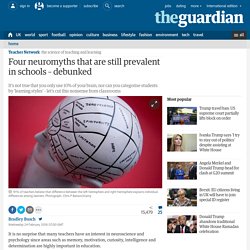
But neuroscience and psychology are complex, nuanced subjects that come with many caveats. Although progress is being made towards understanding what helps and hinders students, there is still a disconnect between the research in labs and what happens in many schools. Many “neuromyths” are rampant in our classrooms, and research suggests that people are often seduced by neuroscientific explanations, even if these are not accurate or even relevant. Research also shows that explanations accompanied by images of the brain also persuade people to believe in their validity, however random the illustration. Such myths are a drain on time and money, and it is important to explore and expose them.
On Flipboard. Four neuromyths that are still prevalent in schools – debunked. 10+ Tips for Using Brain Based Methods to Redesign Your Classroom. “It is not what you do for your children, but what you have taught them to do for themselves that will make them successful human beings.” - Ann Landers As adults, we make choices daily.
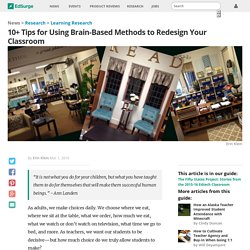
We choose where we eat, where we sit at the table, what we order, how much we eat, what we watch or don’t watch on television, what time we go to bed, and more. As teachers, we want our students to be decisive—but how much choice do we truly allow students to make? Consider the classroom space, for example. By creating an environment that is brain-friendly for students, you also touch on many more of the brain-body compatible elements such as allowing for a safe space for reflective thinking, movement around the room, choice by students, and ease of collaboration. A good friend of mine often reminds me that we aren’t raising a class of second graders, but in fact, we are raising future adults.
Creating a Brain-Friendly Enriched Classroom Environment 1. 2. 3. 4. 5. 6. 7. The Results. Five Research-Driven Education Trends At Work in Classrooms. Increasingly, educators are looking to research about how kids learn to influence teaching practices and tools.

What seemed like on-the-fringe experiments, like game-based learning, have turned into real trends, and have gradually made their way into many (though certainly not most) classrooms. Many educators are using researchers’ insights into how children best learn to inform their teaching practices. Stanford professor Carol Dweck’s research on encouraging children to develop a growth-mindset continues to grow in popularity, as educators try to praise effort, not outcomes. Dweck writes that if children believe their abilities are fixed — that either that they’re smart or they’re not — they approach the world in different ways and aren’t as able to face adversity. When they believe skills and abilities can grow throughout one’s lifetime, they’re better able to rise to challenges. Games have long been used to engage students. Katrina Schwartz. How to Focus on Your Work and Ditch the Distractions. It may be the rarest skill in the modern workplace: the ability to focus.

“Deep work is giving something intense concentration without distraction for long periods of time,” says Cal Newport, a computer science professor at Georgetown University and author of the new book Deep Work: Rules for Success in a Distracted World. “If you’re one of the few who masters this skill, you’ll have a lot of opportunities.” Take Newport, for instance. He eschews social media and carefully schedules meetings and email. So much talk about 'the brain' in education is meaningless.
You may have noticed a steady increase in the use of brain-based language in education recently.
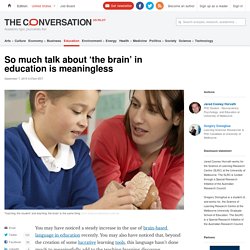
You may also have noticed that, beyond the creation of some lucrative learning tools, this language hasn’t done much to meaningfully add to the teaching/learning discourse. The reason for this is simple: although impressive sounding, the majority of educational references to the brain are devoid of any original, unique or prescriptive value. They are what we have come to call “neurosophisms”. “Neuro” meaning neuron or nerve, and “sophisma” meaning “clever device”, a neurosophism is a sophisticated but fallacious application of neuroscientific language. To get a sense of what we mean, here are a few of the more common types of offences. The first type we’ve termed the Sleight of Hand: when someone coyly sneaks an ultimately meaningless neuroscientific term into a phrase in the hope it will add prestige and weight. Now remove the word “brains” from the sentence above and re-read it. Brain-Based Learning: Resource Roundup. Facebook Edutopia on Facebook Twitter Edutopia on Twitter Google+ Pinterest.
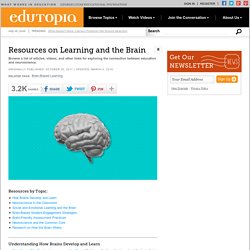
The Neuroscience Of Learning: 41 Terms Every Teacher Should Know. The Neuroscience Of Learning: 41 Terms Every Teacher Should Know by Judy Willis M.D., M.Ed., radteach.com.
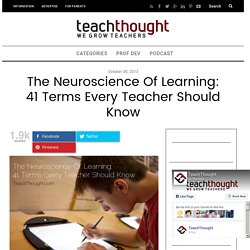
Brain-Based Learning. Mr. Rogers Jams to a Song about how to Turn On Your Brain.